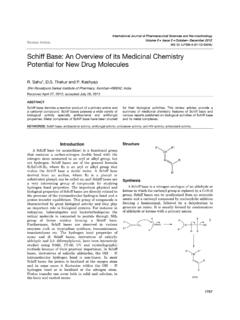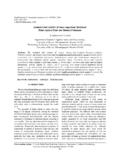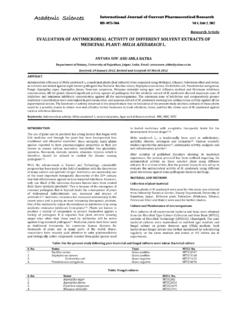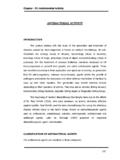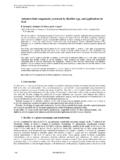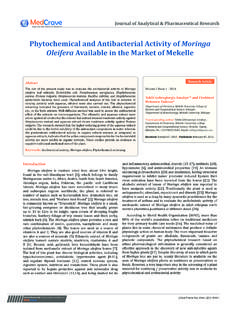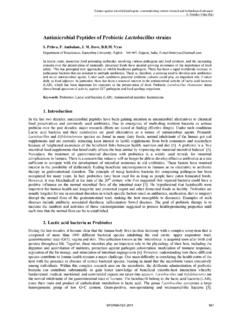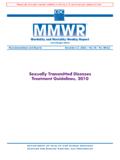Transcription of Pharmacological Activities of Flavonoids: A Review
1 1394 Int J Pharm Sci Nanotech Vol 4; Issue 2 July September 2011 Review Article Pharmacological Activities of flavonoids : A Review A. D. Agrawal Shree Sureshdada Jain Pharmaceutical Education and Research Center, Jalgaon, India. Received April 4, 2011; accepted July 17, 2011 ABSTRACT flavonoids belong to a group of polyphenolic compounds, which are classified as flavones, flavanones, catechins and anthocyanins. flavonoids of different classes have several Pharmacological Activities . flavonoids possess Pharmacological and biochemical effects, which inhibit a number of enzymes such as aldose reductase, cycloxygenase, Ca+2-ATPase, xanthine oxidase, phosphodiesterase, and lipoxygenase.
2 They also have a regulatory role on different hormones like androgens, estrogens and thyroids. In the view of their wide Pharmacological and biological actions, they seem to have great therapeutic potential. KEYWORDS: flavonoids ; biochemistry; pharmacology; therapeutic potential. Introduction flavonoids are a group of polyphenolic compounds, which are widely distributed throughout the plant kingdom and about 3000 varieties of flavonoids are known (Kuhnau, 1976). Many have low toxicity in mammals and some of them are widely used in medicine for maintenance of capillary integrity (Cesarone et al.)
3 , 1992). flavonoids exhibit several biological effects such as anti-hepatotoxic, anti-inflammatory and anti-ulcer activity (Bors et al., 1990; Colerige et al., 1980). They also inhibit enzymes such as aldose reductase, cycloxygenase, Ca+2-ATPase, xanthine oxidase, phosphodiesterase and lipoxygenase. They are potent antioxidants and have free radical scavenging abilities. Many have antiallergic, antiviral actions and some of them provide protection against cardiovascular mortality (Clack et al.
4 , 1950; Hertog et al., 1993). They have been shown to inhibit the growth of various cancer cell lines in vitro, and reduce tumor development in experimental animals (Mori et al., 1988). flavonoids can be divided into various classes on the basis of their molecular structure (Rice-Evans et al., 1996). The four main groups of flavonoids are listed in Table 1, together with the examples and the food source in which they are present. Chemical structures of selected flavonoids are shown in Figure 1. The flavones are characterized by a planar structure because of a double bond in the central aromatic ring.
5 Pharmacological effects of flavonoids Antiatherosclerotic effects. Because of their antioxidative properties, flavonoids are likely to have a major influence on the vascular system. Oxygen radicals can oxidize LDLs, which injures the endothelial wall and thereby promotes atherosclerotic changes. A few clinical studies have pointed out that flavonoid intake protects against coronary heart disease (Hertog et al., 1995; Hertog et al., 1993). Hertog et al., 1995 stated that the flavonoids in regularly consumed foods might reduce the risk of death from coronary heart disease in elderly men.
6 Furthermore, a Japanese study reported an inverse correlation between flavonoid intake and total plasma cholesterol concentrations (Arai et al., 2000). Oxidative stress and vascular damage are postulated to play a key role in dementia, and the intake of red wine is reported to prevent the development of dementia (Orgogozo et al., 1997). The intake of flavonoids appears inversely related to the risk of dementia (Commenges et al., 2000). Anti-inflammatory effects. Cyclooxygenase and lipoxygenase play an important role as inflammatory mediators.
7 They are involved in the release of arachidonic acid, which is a starting point for a general inflammatory response. Selected phenolic compounds were shown to inhibit the cyclooxygenase and 5-lipoxygenase pathways (Ferrandiz et al., 1991; Ferrandiz et al., 1990; Laughton et al., 1991). This inhibition reduces the release of arachidonic acid (Yoshimoto et al., 1983). Quercetin inhibits both cyclooxygenase and lipoxygenase Activities , thus diminishing the formation of these inflammatory metabolites (Robak and Gryglewski, 1996; Kim et al.)
8 , 1998). Another anti-inflammatory feature is that flavonoids also inhibit eicosanoid biosynthesis (Formica and Regelson, 1995; Damas et al., 1985). Eicosanoids, such as prostaglandins, are involved in various immunologic responses (Moroney et al., 1988). flavonoids also inhibit both cytosolic and membrane tyrosine kinase (Formica et al., 1995). Integral membrane proteins, such as tyrosine 3-monooxygenase International Journal of Pharmaceutical Sciences and NanotechnologyVolume 4 Issue 2 July September 2011MS ID: IJPSN-17-07-11-AGRAWAL1394 Agrawal: Pharmacological Activities of flavonoids : A Review 1395 kinase, are involved in a variety of functions, such as enzyme catalysis, transport across membranes, and transduction of signals that function as receptors of hormones and growth factors, and energy transfer in ATP synthesis.
9 Inhibition of these proteins results in inhibition of uncontrolled cell growth and proliferation. Tyrosine kinase substrates seem to play key roles in the signal transduction pathway that regulates cell proliferation. Another anti-inflammatory property of flavonoids is their suggested ability to inhibit neutrophil degranulation. This is a direct way to diminish the release of arachidonic acid by neutrophils and other immune cells (Hoult et al., 1994; Tordera et al., 1994). TABLE 1 Main groups of flavonoids , the individual compounds, and food sources.
10 Group Compound Food sources Flavones Apigenin Apple skins Chrysin Berries Kaempferol Broccoli Luteolin Celery Myricetin Fruit peels Quercetin Lettuce Rutin Cranberries Sibelin Grapes Olives Onions Parsley Flavanones Fisetin Citrus fruit Hesperetin Citrus

